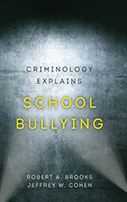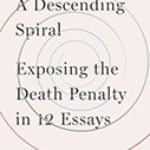Criminology Explains School Bullying

Authors: Robert A. Brooks and Jeffrey W. Cohen
Publisher: Oakland, CA: University of California Press, 2020. 232p.
Reviewer: Rachel Maunder | August 2021
Criminology Explains School Bullying claims to provide a ‘concise, targeted overview of the major criminological theories to explain the phenomenon of school bullying’ and help to explain potentially complex ideas using applied examples. The focus of the book is on ‘why’ school bullying happens -seeking to examine different criminological theories that could be used to explain it. According to the authors, one of the drivers for the book was seeing how useful their students found applying different theories to the same problem in class, because it enabled them to directly compare them and see connections among them. In the case of school bullying, there are certainly few examples of literature to date presenting multiple contrasting theories alongside each other in the way that this book does.
The authors are both established scholars in Criminal Justice, and have previously co-authored a text on bullying entitled ‘Confronting School Bullying: Kids, Culture and the Making of a Social Problem’. As a psychologist who has studied school bullying for over 20 years, I was keen to review this book to see how Criminologists explain the phenomenon. Importantly, the authors set out in the introductory chapter that whilst they are supportive of using criminological theory and see its potential, they do not condone the criminalization of bullying. As such, they are against punitive approaches which they argue can be counterproductive. I thought this was a valuable point for them to make, and I like the way they sought to make their position clear from the outset, whilst also giving due attention in the book towards theoretical explanations of which they may not always be supportive.
The text is organised into seven chapters plus an Introduction. The Introduction provides the background to how the book came about, and what the authors are trying to achieve from it. Chapter 1 then provides an overview of the field of school bullying and what is currently known about it. Chapters 2 to 7 focus on the application of theory to explaining bullying, with each chapter covering theories that share common underlying principles or assumptions. Each of the theoretical chapters introduces the basis for the theories covered and their core ideas. The theories are then applied directly to explain school bullying, with evidence for and against them discussed. There are real-world applications, and a targeted section on implications for policy and practice in each chapter. There are also case examples with critical thinking questions to help challenge readers and to reflect on the issues raised.
I found the text thorough, engaging, and informative. The content, layout and structure work well, and there is widespread coverage of the topic from different perspectives. The case examples and policy context are focused on the United States, so it is clear that the book is orientated towards an American market. That being said, I still think international readers could get a lot from it.
The Introduction opens with an anecdote from the authors about a disparity in media coverage between two adolescent cases of suicide linked to bullying, despite their similarity in time and place. This example of differential media reporting illustrates the importance of wider social representations of bullying, and provides a useful precursor to the remainder of the book. It also leads to the authors emphasizing the value of the social-ecological model as a way of understanding school bullying in context. Their support for this approach reflects the trend in published work where there has been increased attention on social and cultural processes and the complexity of factors that contribute to bullying. As such, the content is timely and reflective of current thinking in the field.
Despite the authors being clear about their own position from the start, I thought their coverage of the various theories (many of which likely contrasted to their own views) was balanced, fair, and well-considered. It is pleasing to see a critical stance adopted, with evidence for and against the theoretical ideas presented in each chapter, but readers should also be able to make their own judgements in response to the material.
Chapter 1 provides readers with useful coverage about the nature, scope, and response to school bullying. This holistic overview of what is known about school bullying provides a valuable backdrop for the subsequent chapters where particular theoretical explanations are examined in turn. This begins in Chapter 2, where deterrence, rational choice, and victimization theories are considered. These explanations focus on free will, individual choice, and proximity and exposure to bullying. Micro-level theories which attend to biosocial and psychological factors are examined in Chapter 3. This includes sections on genetics, endocrinology, health, personality, cognitive functioning, and social learning as explanations for bullying. In Chapter 4 the focus is on social structures, where explanations around socioeconomic status, social disorganization, strain theories and cultural conflict are discussed. This forms a logical progression to Chapter 5 which looks at social processes. In this latter school of thought, the behaviour of individuals is seen to be influenced by forces around them, such as families, peers, and the institutions they engage with. There are sections here on learning theories, control theories and labelling which attend to the potential role of socialization processes and social interactions on bullying behaviour. Chapter 6 is about critical criminology and restorative justice, where the contribution of culture, feminist and queer theories, critical race theory and restorative justice approaches are examined. Within these critical perspectives, attention is on the social structures, inequalities and power which position bullying as a form of oppression and exclusion. The final chapter covers integrationist, life course and developmental theories. Here the authors introduce several models which seek to integrate constructs from different theories. The final section is about the socio-ecological model, which is introduced as a ‘metatheory’ that can bring aspects of various theories together to provide a holistic approach.
The book is structured in a logical order, with the theoretical coverage in each chapter progressing from those focused on individual choice and personal factors, building to local level social influences, then to larger structural issues and finally integrative perspectives which recognise multi-layered influences. There is a strategic ordering to the chapters so that the final chapter covers approaches more closely aligned to the authors’ perspective, although the authors are transparent from the start that they emphasize the ‘social-ecological model’, and they do seek to give objective and impartial treatment of the various theories presented.
There is extensive integration of scholarly literature throughout, and the discussion is consistently evidence-based. The text is comprehensive, and an excellent resource for people wanting to gain a rounded insight into the various explanations for school bullying. I was impressed by the range of theoretical perspectives covered, and the balanced consideration the authors provide about each one. This is the first book of its kind that attends so thoroughly to this many theoretical explanations within the same resource.
What struck me was the fact that the theories purported to be criminological often overlapped with theories drawn from psychology. As such, despite the fact that I am not a criminologist, I had knowledge and understanding of the majority of the theories covered. This really highlighted to me the intersections between subject areas, and blurred disciplinary boundaries. Although scholars may be positioned in different disciplines, they have a lot of shared knowledge that can complement our understanding of social issues. It did make me wonder if labelling this book as ‘Criminology explains…’ perhaps limits the potential readership who would see this as relevant. The synopsis on the back states that it will be suitable for criminology or classes on juvenile delinquency. There could be the risk therefore that a psychologist, educationalist, or sociologist would see the title and assume that it is not aimed at them, despite its content being appropriate for a multidisciplinary readership. This book’s value lies in the breadth of theoretical coverage, and therefore anyone with a professional or academic interest in bullying would find it insightful.
I suspect that we could gleam similar benefits from bringing together scholars and practitioners from various subject backgrounds and professional roles to provide insight on school bullying. With everyone having the shared goal of addressing school bullying, I am sure we would have much to learn from each other.
Dr Rachel Maunder, Associate Professor in Psychology, The University of Northampton, England


